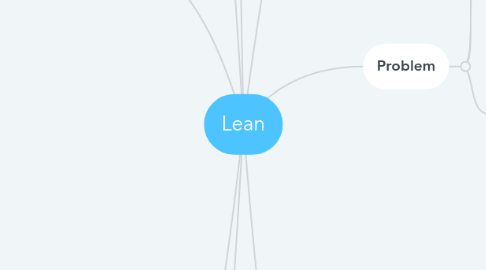
1. Principles (Womack & Jones, 2003)
1.1. 1. Identify customers & specify value
1.1.1. Value can only be defined by the ultimate customer, value is created by the producer
1.2. 2. Identify & map the stream
1.2.1. mapping the valuestream must go beyond the firm --> lean enterprise
1.3. 3. create flow by eliminating waste
1.3.1. need to move away from the 'batch-and-queu' mode
1.4. 4. respond to customer pull
1.4.1. It is because the ability to design, schedule, and make exactly what the customer wants just when the customer wants it means you can throw away the sales forecast and simply make what customers actually tell you they need.
1.5. 5. pursue perfection
1.6. Essence: Creating value, reducing waste
2. Lean management
2.1. Purpose - Process - People
2.1.1. Formula Womack to evaluate your lean efforts
2.1.1.1. 1. examine your purpose
2.1.1.2. 2. examine your process
2.1.1.3. 3. examine your people
3. Challenges
3.1. external & internal environment
3.1.1. 4 main internal challenges
3.1.1.1. Process not well organised/managed
3.1.1.2. Process not effective/efficient
3.1.1.3. wrong approach: supplier orientated
3.1.1.4. emphasis on parts, not on whole
3.2. Rising demand
3.2.1. Covered in 'Economics of HC'
3.3. Rising demand for quality
3.3.1. 'Innovation and Quality Management'
3.4. Scarcity
3.4.1. Economics of HC
3.5. Competition
3.5.1. 'Economics of HC; 'Governance'
3.6. Expensive resources
3.6.1. Economics of HC; Governance
3.7. organisation
3.7.1. 'Patient Flow'
3.8. Waste
3.8.1. 'Patient Flow'
3.9. Are the motives for Lean
4. in Healthcare (Mazzacato)
4.1. general components of Lean thinking
4.1.1. methods to understand processes in order to identify and analyse problems
4.1.2. methods to organise more effective and/or efficient processes
4.1.3. methods to improve error detection, relay information to problem solvers, and prevent errors from causing harm
4.1.4. methods to manage change and solve problems with a scientific approach
4.2. most common areas of improvement with lean applications
4.2.1. time savings & timeliness of service
4.2.2. cost reductions or productivity enhancements
4.2.3. several quality aspects
4.3. advice to organisations regarding lean thinking
4.3.1. implement methods that help relay information to problem solvers and create stable structures for continual improvement
4.3.2. Engage management in continual problem solving
4.3.3. Embrace a more holistic approach and connect to a larger context
4.4. You would use Lean thinking in departments who standardized their work quickly.
5. Tools to deal with waste
5.1. Value stream mapping
5.2. 5S
5.2.1. a rigurous form of housekeeping whih supports the persuit of eliminating waste.
5.3. Kaikaku
5.4. MRP
5.5. Just in Time
6. History
6.1. Adam Smith (DoL)
6.2. Eli Whitney (standardized parts)
6.3. Frederick Taylor (foundation for standardized work, 'one best way')
6.4. E. Deming (PDCA method (Quality improvement))
6.5. Henry Ford (combined DoL, 'one best way', and standardized parts. The moving assembly line)
6.6. K. Toyota ( automatic looms, 'just-in-time')
6.7. T. Ono (Toyota Production System (TPS))
6.8. Jim Womack (term "lean", Lean thinking)
6.9. NHS 2002
6.10. Constantly try to optimize the flow
7. Problem
7.1. Mura
7.1.1. Uneveness
7.2. Muri
7.2.1. Overburden
7.3. Muda
7.3.1. Non value added
7.3.1.1. Unused human potential
7.3.1.2. excess motion
7.3.1.3. Waiting
7.3.1.4. Overproduction
7.3.1.5. Overprocessing
7.3.1.6. Defects
7.3.1.7. Inventory
7.3.1.8. Transportation
8. The Toyota Way (14 methods Pyramid) 4P's
8.1. Philosophy
8.2. Process (eliminate waste)
8.2.1. 7 methods
8.2.1.1. 1. create continuous process flow to bring problems to the surface
8.2.1.2. 2. Use pull systems to avoid overproduction
8.2.1.3. 3. Level out the workload
8.2.1.4. 4. Build a culture of stopping to fix problems, to get quality right the first time
8.2.1.5. 5. Standardized tasks are the foundation for continuous improvement and employee empowerment
8.2.1.6. 6. Use visual control so no problems are hidden
8.2.1.7. 7. Use only reliable, thoroughly tested tech nology that serves your people & processes
8.3. People & Partners
8.4. Problem Solving
8.5. Other approaches
8.5.1. TQM
8.5.1.1. A way of working which focuses all participants on quality, driving long term success through customer satisfaction
8.5.2. Six Sigma
8.5.2.1. A structured approach to data driven problem solving
8.5.3. BPR
8.5.3.1. An approach to transforming activity through process change
8.5.4. Kaizen
8.5.4.1. An approach to continuous incremental improvement, creating more value and less waste
8.5.5. Agile Management
8.5.5.1. integrates mass custimization & ; high flexibility and responsiveness

